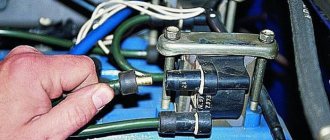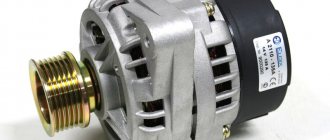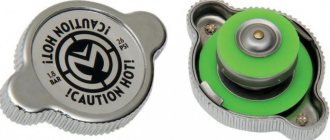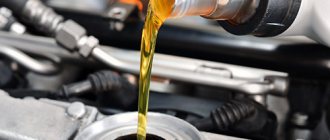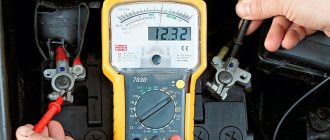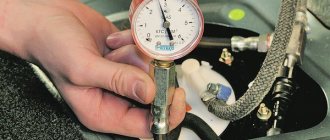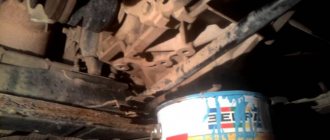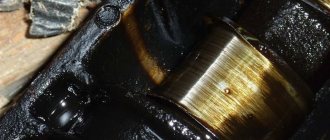Solutions
If you have points 2 and 5, then nothing can be done - just carry out the appropriate repairs - replacement. But in all other cases the problem can be cured. However, there are temporary alternatives.
Procedure
First of all, we try to change the oil. We will also replace the oil filter with it. Sometimes it can be a source of low pressure, due to the fact that its valve simply does not hold the accumulated pressure. True, in this case the pressure will disappear only when the engine starts. And yet, the pressure rises by as much as half a bar, provided that it is at least somehow present. However, if there was dirt in the engine caused by old oil, then the problem may be solved.
If the first option does not help, we flush the engine and be sure to remove the pan after draining the dirt. We look at the condition of the oil receiver grid. It is a common cause of pressure problems, especially on VAG engines. It is better to use a wash with good solvent properties, otherwise it will pick up dirt and clog the channels with it. If the engine has not had its oil changed for a long time and there is too much dirt, then it is better not to wash it. It's easier to disassemble it and wash the parts separately.
The third option, if it’s just for a while, is to fill in high-viscosity oil. For example, instead of 5W40, fill in 15W50. The higher the temperature, the faster the oil becomes liquid. Therefore, the oil indicator is a very important parameter. After all, when it is thick, the pressure is much higher.
That's all the ways to increase engine oil pressure.
Source
1. Insufficient amount of engine oil in the engine
Adding more grease when changing does not always guarantee constant pressure. There are times when oil is used improperly due to leaks, evaporation and other factors. Some car owners skip checking the engine oil level. To avoid serious damage to the engine, be sure to check the level. It is also important to consider that as an engine ages, it will burn more oil and increase its consumption. The best thing to do is to top up the engine oil level. Also, if there are drops of oil under the car, this could be a sign of a leak. If any leak is found, you need to fix it as quickly as possible. Finally, proper oil change schedules and intervals must be followed to ensure adequate pressure.
Viscosity too high or too low
Very low or high viscosity is also one of the reasons for low oil pressure. Viscosity is the density of the oil used in the engine. Due to its density, high viscosity oil does not flow as quickly. This leads to a slow increase in pressure. This should also be taken into account at low temperatures. Low oil viscosity, on the other hand, results in low flow resistance. It moves faster through the passages and is registered by the pressure gauge as low pressure. The key to avoiding low pressure is choosing the right lubricant viscosity. The recommended viscosity grades for the engine must be observed.
5. Defective oil pressure gauge
There are times when the oil level is correct, but the pressure gauge shows a different value. If this happens and there are no unusual high temperatures or noises, the problem may have something to do with the pressure gauge. There are sensors to monitor the oil pressure in the car in real time. But if they are no longer working correctly, you can choose to replace the sensor or check if the problem is due to a bad oil pump.
Whether new oil is used or not, maintaining the correct level is critical to keeping your vehicle in good shape. Not having enough oil can cause serious problems. Therefore, you need to take the time to regularly check your oil levels, maintain your oil filters, and most importantly, keep up with your vehicle's regular maintenance.
Source
Ways to combat excess pressure in the oil system
Each disease manifests itself with certain symptoms. In accordance with them, a special method of treating the disease is being developed.
Methods for dealing with high oil pressure in a power plant are selected based on the reasons for its occurrence:
- if the viscosity is inappropriate, a lubricant change will be required, taking into account the operating conditions of the unit, including temperature conditions;
- Elimination of blockages in oil-conducting channels and other elements of the system is carried out using special means available on the modern market in huge quantities. Lubricant filters also need to be cleaned or replaced periodically;
- Regular technical inspections contribute to the timely detection of faults in the system valves. Unsuitable or damaged parts must be replaced immediately. Moreover, each element must be selected individually, taking into account the design features of a particular power unit.
As you can see, there is nothing complicated in preventing excess pressure of motor lubrication in the engine oil system. Even an inexperienced car enthusiast can handle it on his own. And if such a situation arises, perform fairly simple manipulations with your own hands to eliminate the problem, such as replacing an oily substance or parts unsuitable for normal use.
Low oil pressure: causes and solutions
Most vehicle owners have encountered an indication on the instrument panel indicating insufficient oil level in the system. Sensor failure situations are considered the simplest. Replacement is quick and inexpensive. All other cases indicate serious problems with the engine. The defect can be identified and eliminated in a professional service center.
The main reasons for the indication on the dashboard are low engine oil level or similar pressure indicators. The exact state of the system can only be determined using diagnostics on modern equipment, or by understanding the operating instructions. Most cars in the budget price category are equipped only with oil pressure indicators.
The main reasons for the drop in lubricant pressure
If the warning light comes on, it means that the oil pressure has dropped to a critical point. The main reason for this is the failure of the oil pump. The pump stops circulating lubricant through the system, which leads to a sharp increase in temperature in the engine.
Be sure to watch the video:
Before determining the malfunction, you need to make sure that the pressure warning lamp is actually working (if the pressure gauge shows a sharp drop in pressure and the lamp does not light up). It must be unscrewed from the socket and inspected; if the filament has burned out, the lamp should be replaced. If it is intact, then you can apply voltage directly. It should be remembered that the voltage in a car electrical network is not the same as in an apartment or private house. Usually the operating voltage is written on the lamp base.
Also, the sensor itself, which shows what oil pressure is in the engine, may be broken. In this case, it must be removed from the engine and use a conventional hand pressure gauge.
If the light does not light, but the pressure gauge shows that the pressure is low, then you must first check the oil level. If there is insufficient lubricant, the pump simply will not be able to create the required pressure. The total amount of lubricating fluid in the system must be constantly maintained at the level required by the operating instructions. To do this, before each trip you need to take out the oil dipstick and look at what mark the level is. If it is minimal, then the oil must be added. But don’t get carried away; a high level of lubricant will lead to rapid overheating.
There is another very important reason why the drop in oil pressure in the system occurs gradually, but the result will be the warning light coming on. This is a fuel pump leak. After fuel enters the lubrication system, the lubricating fluid dilutes, which will lead to a loss of viscosity. The viscosity of the oil will deteriorate the faster the more the fuel pump leaks. To check the oil, you need to drain a small amount of it and determine “by nose”. The smell immediately makes it clear whether fuel is entering the lubrication system or not.
If the forced ventilation channel is clogged, exhaust gases and lubricant will enter the air system. This will also lead to a decrease in pressure in the oil system. High levels of exhaust and lubrication can significantly disrupt the operation of the engine, the overhaul of which will cost a considerable amount. Therefore, it is best to carry out control measurements as often as possible. The ideal option is to display the pressure gauge on the dashboard.
We recommend: The steering wheel pulls to the left or right - what could be the reasons?
Leaving the oil filter for too long can also cause a drop in oil pressure. If the filter is bad and has not been changed for a long time, then it is best to immediately replace it with a new one. Set the next one not after the time specified in the instruction manual, but after 1000 km. You should not save money on the oil system and simply wash the filter in gasoline or diesel fuel. The oil filter is a consumable item and can only be replaced.
The main failure in the system is considered to be the failure of the oil pump. This is easy to determine - the lubricant does not circulate in the system and the engine quickly heats up. To repair the pump, you can purchase a repair kit, or simply replace it with a new one.
What to do if oil pressure drops to critical levels
For most vehicles, an illuminated oil can indicator on the instrument panel indicates insufficient lubricant pressure. If the light goes out after a few seconds, you must monitor it closely throughout the route. Most often, such symptoms appear in winter, especially when the car starts cold. The indication appears when the vehicle rolls heavily when turning.
If the indication is constant, you must contact a service center and stop using the vehicle. A critically low fluid level indicates insufficient oil in the crankcase. The driver needs to check the level with a special dipstick and, if necessary, add a similar composition. In most cases, this measure is enough for the indication to disappear. You will need to continue monitoring the dashboard for some time. If the oiler appears again, you must contact service.
A more serious cause of the indication is the failure of the oil pump. If, when checking the oil level, a sufficient amount is found, most likely the problem is with the pump. The consequences of such a defect are insufficient lubricant circulation in the engine. The consequence is engine failure and expensive repairs.
At the first indication of an oil can on the dashboard, the best thing the driver can do is stop on the side of the road. The engine must be turned off and it is advisable to allow it to cool. This sequence of actions is explained by the potential risk of engine failure. If the volume and pressure of lubricant are insufficient, the motor operates under heavy loads and can quickly fail. In many cases, a breakdown of the power unit is detected after just a few minutes of such work.
A scheduled oil change may also be accompanied by a breakdown indication on the instrument panel. When using high-quality lubricant recommended by the manufacturer, the oiler disappears 10-20 seconds after starting the engine. Otherwise, you need to check the filter element. It is advisable to immediately replace it with an original part.
Oil pressure sensor failure - what to do
For most modern vehicles, the engine oil pressure level should be 0.5 kgf/cm2 or more. Such indicators are recorded at engine speeds of 800-900 per minute. Exceeding the pressure level is also unacceptable. Most sensors are configured to operate the power unit in the range of 0.4-0.8 kgf/cm2. Approaching the measured value to the upper and lower limits triggers the indicator.
Any such situation is potentially an emergency. Therefore, it is necessary to stop and try to determine what exactly is causing the defect. To do this, you need to raise the speed of the power unit to 1000 and check the status of the indicator. If the oiler disappears, the lubricant pressure is fine. Otherwise, you need to contact a service center as soon as possible and check the engine on a stand.
If the indicator works incorrectly, it is enough to clean it. To do this, the unit is dismantled. Each oil channel is thoroughly washed. After removing the blockages, there should be no false alarms. If such situations are repeated, the entire node changes.
How to check oil pressure yourself?
The engine oil pressure is checked only when the engine is well warmed up and the operating temperature reaches 90°C. After warming up, the engine must be turned off and the oil pressure sensor removed from the oil line. A manual pressure gauge is installed in its seat. Next, start the engine again and measure the oil pressure at idle, be sure to write down or remember the readings. After this, add gas until the engine speed exceeds 5000 rpm and take the readings again. The operating manual will tell you which readings are optimal for the car. Each car should have different engine oil pressure, since this indicator is affected by the number of cylinders and their displacement. If the check shows underestimated figures, then you should take the car to a car service center and have the oil system diagnosed.
Is the oil sensor ok, but the oil light is still on?
It is most difficult to determine a breakdown if the oil sensor is operational and operating normally. First of all, the vehicle owner checks the lubricant level with a standard dipstick. If the amount of fluid in the crankcase gradually increases, gasoline or antifreeze most likely gets into the oil. To confirm the guess, the probe is lowered into a container of water. If there are gasoline stains, a visit to a car service center and subsequent repairs are necessary.
Failures of the power unit, as a result of which an indication in the form of an oil can appears, can be easily noticed independently. Most often the car becomes sluggish. Accelerates poorly, traction and power are lost. At the same time, an increase in fuel consumption and the appearance of thick exhaust are recorded.
In winter, the indication may appear when starting a cold engine and at low temperatures. This effect is not a malfunction. After a few seconds the light goes out. The reason is the thickening of the lubricant and its flow to the lower part of the motor. The engine needs time for all channels to fill with lubricant. It is for this reason that the indication continues to light, in most cases for no more than 3 seconds. After the oil is distributed through the channels, the indication disappears.
There is no oil pressure in the engine or the pressure drops: causes and solutions
It is well known that an internal combustion engine is a power unit that contains a large number of loaded parts and components. For normal operation of the internal combustion engine, such parts require constant lubrication, which is provided by the engine oil system. The working fluid in the system is engine oil.
In the lubrication system, oil is supplied through separate channels under a certain pressure, which makes it possible to effectively lubricate parts experiencing dynamic and other loads. In this case, during the operation of the engine, you may encounter a loss of oil pressure in the engine. The driver may notice that the oil pressure lamp is blinking when the engine is warm, the oil pressure drops at idle speed, etc.
In this article we intend to talk about what oil pressure should be in the engine, why there is no oil pressure in the engine, and also how to check the oil pressure in the engine on a gasoline or diesel internal combustion engine using accessible methods. At the same time, the question of what an engine additive does to increase oil pressure and how effective such a solution can be considered will be considered.
How to check the pressure in the system?
A warning light that indicates an emergency condition of oil pressure is absolutely necessary.
However, like all electrical appliances, it can burn out, its contacts can become unusable, and there are also a number of cases when its signals can be false. Therefore, checking the oil pressure should be carried out periodically.
For diagnostics, we will need a special pressure gauge to monitor oil pressure; if you don’t have one, we recommend purchasing one, fortunately, it is inexpensive and can always come in handy.
- We start the engine and wait for its temperature to rise to operating temperature, that is, 90°C.
- Next, we turn it off, find the oil pressure sensor, unscrew it and screw the pressure gauge into the vacant space.
It's easy enough to rip off the nut and then just unscrew it by hand.
- Then we start the engine and let it idle. We record the readings on the pressure gauge.
The pressure gauge readings are increasing.
- Then, using the gas pedal or throttle cable, we raise the engine speed to 5 thousand and also record the indicators.
Please note that if you have an on-board computer, it is possible to connect data coming from the fuel pressure sensor and then they will be accurately visible in digital form.
Engine oil operating pressure indicators
Any car operating manual indicates what operating oil pressure in the engine is required specifically for each engine. As for the 16-valve VAZ-2112 engine, the figures are equal:
- At idle speed: 2 BAR.
- At 5 thousand revolutions: from 4.5 to 6.5 BAR.
Low engine oil pressure: causes of malfunction
As already mentioned, a decrease in oil pressure is indicated by the lighting of the warning light on the instrument panel. Note that the indicated oil light does not have to be on constantly. There are cases when the oil pressure light comes on when the engine warms up, but there is no such problem on a cold unit.
A similar situation occurs with idle speed. At idle, the oil light comes on or blinks, but after increasing the speed to a certain value, it quickly goes out. In such cases, it is necessary to stop operating the car and find out why there is no oil pressure in the engine, the causes of the malfunction, and also decide on ways to eliminate them.
- First of all, it is necessary to inspect the internal combustion engine from above and below for obvious oil leaks, and check the oil level in the engine. Insufficient lubricant will cause pressure to drop and oil starvation to occur.
- The next step is to check the condition of the oil itself. It is not allowed to use a material that is too “liquid” or viscous, which is not intended for this type of engine by the internal combustion engine manufacturer. It is the first case that often leads to the fact that low-viscosity oil is not able to create the required pressure.
Let us add that for this reason the oil pressure often drops on a warm engine (the gaps between parts increase with heating, and the rising temperature causes the lubricant to become very thin). At the same time, while the engine and oil are cold, the lubricant viscosity is sufficient, that is, the light does not light up.
- Another emergency reason for a decrease in oil viscosity is that working fluid from the cooling system (antifreeze, antifreeze) enters the lubrication system. As a result, coolant enters the engine crankcase and the oil is diluted with coolant. While the oil pump is operating, the lubricant foams, the pump captures foam, and productivity decreases.
In other words, the lubrication system is not able to create the necessary pressure, and the oil itself loses its properties. The cause of coolant ingress may be a crack in the cylinder head or cylinder head, destruction of the cylinder block gasket, etc.
You can identify the problem by the thick white exhaust, as well as by the presence of an emulsion on the oil filler cap or on the dipstick. Also an indirect sign is a decrease in the coolant level in the expansion tank of the cooling system, while the oil level in the lubrication system will increase.
- It should also be noted that the properties of the oil can be greatly influenced by the fuel entering the crankcase. If the engine is faulty (for example, there are problems with the quality and ignition of the fuel mixture, there is low compression in the cylinders, the injectors are leaking, etc.), then fuel is supplied to the combustion chamber, but no charge is burned.
If combustion does not occur in the cylinders, then the engine runs rough, runs intermittently, smokes, and overuses fuel. An increased oil level and a distinct smell of fuel in it, as well as light spots and severe dilution, will indicate the presence of fuel in the lubricant.
- The oil filter deserves special attention, as it may turn out to be a fake or defective. If the filter does not have a shut-off valve or lock washer, then after stopping the engine, lubricant from the channels and filter will drain into the crankcase.
Further startup results in insufficient pressure in the system for several seconds, since during this time the filter is filled with oil. Naturally, until the pressure rises, the oil light will light, then go out. However, the problem will repeat after each stop and subsequent start.
Severe contamination of the oil filter, as well as untimely replacement of it, can also lead to a similar effect. The shut-off or pressure relief valve in the system may become jammed due to trapped debris, deposits, etc.
- The oil pressure in a diesel engine or gasoline unit may also be low due to lubricant leaking from under the oil pressure sensor. In this case, the pressure in the sensor area will not be enough. The warning light may come on intermittently or constantly, at idle, while driving at low or high speeds.
During long-term operation or for other reasons, the oil receiver becomes heavily contaminated. Its mesh often becomes clogged, as a result of which lubricant is not supplied to the engine.
- Malfunctions of components and parts of the engine itself are also the cause of low pressure. In this case, we can talk about serious wear or damage, which leads to the fact that the oil does not meet the required resistance when supplied. It turns out that the pressure naturally drops.
Such a decrease in pressure can be caused by a worn crankshaft and its bearings, wear and tear in the area of the camshaft, CPG, piston rings, etc. Quite often, low lubricant pressure in such cases indicates the need for serious or even major engine repairs.
Reasons for decreased oil pressure
Many beginners have little idea of what low blood pressure can mean and what causes it. Let's look at the main ones.
- Lack of oil in the mechanism. It is necessary to check the oil level with the engine stopped. Add oil only of the same viscosity and brand that was before. We check the pressure.
- Increased oil filter resistance. This situation occurs after installing a filter that is intended for a different motor model.
- Problems with the oil pump. Malfunctions appear when there are certain contaminants, deposits on internal elements, and contamination of the oil filter. Also, the pump may simply wear out.
- Reducing valve jamming - here you will have to open the oil pan, remove the pump and find out the more precise cause of the problem.
- Large gaps between engine elements resulting from wear.
- Diluting the lubricant with fuel or special coolant. This provokes a decrease in oil viscosity and a subsequent decrease in pressure.
- Cylinder failure. In such a situation, the fuel does not burn in the cylinder, but gradually enters the crankcase, mixing with oil.
- Ventilation system failure. An excess volume of crankcase gases is formed, which will cause a decrease in pressure levels. The cause may be a faulty crankcase ventilation valve.
Emergency oil pressure sensor
The oil pressure light came on: emergency
So, if the oil pressure light is on or blinking, this means that the pressure in the lubrication system has dropped, the engine must be turned off as soon as possible.
- Even if obvious leaks are not visually visible (for example, the valve cover is dry, there are no traces of oil on the cylinder block), and the oil level is low, then you should carefully inspect the installation location of the oil filter and oil pressure sensor.
Also, special attention should be paid to the front and rear crankshaft oil seals and the junction of the engine sump. Many cars will require a detailed inspection from below, which is difficult to do without a pit or lift.
- If a leak is detected, you need to add suitable oil (in case of severe leakage, overflowing slightly above the level is allowed). The engine can then be started. If the light goes out, then you can drive to the service station under your own power without loading the engine.
- If the lubricant level is low and there is no pressure, and no leaks are detected, then the lubricant needs to be added. After this, the engine is started to evaluate the color of the exhaust. Blue or bluish oily smoke from the exhaust pipe will indicate that the piston rings may be stuck, the rings are worn out, or there are problems with the cylinder bore (scuffing).
In other words, lubricant consumption is greatly increased (the engine eats oil). Increased pressure in the crankcase and problems with valve stem seals also lead to increased consumption. If after topping up the light does not light up or blink, then you can drive to the service station on your own, after which in-depth diagnostics are carried out.
Please note that if adding oil to the level does not solve the problem (the light on the panel is still on), then you cannot drive the car under your own power. It is also not recommended to tow the vehicle using a cable. It is best to call a tow truck to deliver the car for repairs.
Why does the oil pressure light come on? The engine has 8 or 16 valves, also at idle
Perhaps a very burning question is about the oil pressure light; when it lights up, the driver understands that something bad has happened to the engine, but what? How to understand? Today I will try to collect all the cases in which it can light up, this appears on almost all engines, regardless of the number of valves, even if it is used
It will be 8 or 16. Often it can blink even at idle. In general, there are a lot of reasons, let's figure it out...
I want to warn you right away that you CANNOT ignore this sensor! It lights up only in emergency situations, and your intervention and attention is required. If you wait for some time, then you can simply “ruin” your unit, and then a major overhaul is not far away. So if the lamp lights up or starts blinking, we urgently look into it.
About oil pressure
Previously, almost all cars were equipped with a special “screen” where the pressure in the engine was indicated. The scale measured it in units such as - kgf/cm2. The higher the engine speed, the higher the pressure became; if it was not enough, a special lamp would light up, signaling possible malfunctions. Now on modern cars this “screen” has been removed, it has been gone for a long time! Well, if only on some UAZ, and then not always, only the lamp remains. But it is advisable to know normal pressure.
Normal pressure at idle (from 800 to 1000 rpm), approximately from 0.5 kgf/cm2. I would like to note that for many 16 valve engines it can be a little more, about 0.6 kgf/cm2. This is because they are more revving and their oil is thinner.
This pressure is measured by a special sensor; if the parameters deviate, it lights up a special lamp, which signals that not everything is in order with the engine. As a rule, if the pressure drops to 0.4 kgf/cm2, the lamp begins to blink or burn briefly. Which already signals to you that something is wrong here. But it’s not always a matter of pressure; there are banal reasons, just the driver’s faults.
Simple malfunctions - about “lubrication”
The very first and most common reason is insufficient amount of oil in the engine. Beginners neglect the level and do it in vain. It’s quite simple to determine - we pull out the oil dipstick and see if it’s dry, then we should sound the alarm - we MUST add it to the required level, the engine is experiencing “oil starvation”. Fortunately, now the sensor is triggered at a critical but acceptable level.
Second - not timely replacement! Some of us drive on oil for more than 20, or even 30,000 kilometers; it simply turns into mush, after which it is very difficult to wash the inside of the engine! Accordingly, if there is no liquid lubricant, the lamp will signal you about this; such behavior is simply unacceptable. Often the engine cannot be saved, this is especially true on loaded units, for example, on TURBO. So we set ourselves a rule: we MUST change the oil as prescribed by the dealer, and I would even change it even more often, for example, now that my warranty has expired, I change it after 10,000 km, instead of 15,000 recommended by the official dealer.
In 50% of cases, the indicator lights up precisely because of these reasons, so remember them, they are really important, if you follow these rules, then perhaps your sensor will never light up.
Moderate causes - maybe a sensor?
Here it is worth mentioning options from which any driver is not protected, that is, practically not to blame. SO:
1) The pressure sensor has failed, this is a trivial problem with CHEVROLET engines; if the engine is not warmed up, the oil simply “breaks through” the sensor, and it begins to “leak” - it does not show the correct data, even if your level is normal, it will constantly signal you. What to do - just change it! Many cars have this problem, and therefore in winter we warm up the engines at idle - a must! It manifested itself like this, here is the video.
2) Wrong oil! Rarely, but it happens. Now, however, all manufacturers indicate the tolerance standards that need to be poured into their motor (for example, 5W - 40, 5W - 30), however, there are those who “don’t understand” who can fill in a brand and tolerances that are not designed for your unit (for example, 0W - 20) , what's happening? Such oil is either very liquid, or, on the contrary, very thick, the pressure begins to jump from normal - the pressure lamp lights up! Therefore, we are not being “wise”, we are pouring what the doctor ordered. If you don’t know which one, go to the forums for your model, everything has already been written there a long time ago.
3) Antifreeze or antifreeze gets into the engine crankcase. Unfortunately, this is not uncommon - the gasket between the engine block and the head breaks, and the coolant simply flows into the oil. Accordingly, the lubricant loses its properties, becomes liquid and can no longer withstand the required pressure (that is, it drops below 0.4 kgf/cm2). This malfunction is easy to determine; your coolant level will constantly drop, and there will be no drops under the car anywhere. And the oil level is constantly rising! In general, you need to take urgent measures, otherwise the engine will “knock.”
These are reasons that already require intervention in the inside of the unit, but they are moderate in severity, some are the most complex.
Complex reasons - that the oil filter
Yes guys, as strange as it may sound, the root cause may be the oil filter, and this manifests itself very often.
1) Oil filter - if you change everything at an official station, then be sure that they will supply you with original spare parts. But there is no guarantee - when you do it yourself! As a rule, you buy non-original spare parts, which can often be counterfeit (assembled in handicraft factories in China), the key factor for you is the price, you can understand! But such filters simply cannot hold pressure, how does this manifest itself? A cold engine or one that has been standing for a long time - you try to start it, it starts and after the first few seconds after starting, maybe from 3 to 10, the pressure lamp comes on, you can hear the knocking of the hydraulic compensators, if you have them. The thing is that the oil filter must have a special valve (check valve) or washer (locking washer) that locks the oil when the engine is turned off, that is, it should not flow into the pan, but be in the system. This is true for normal manufacturers, but for “fake” ones, this is completely far from reality - as a result, the oil drains and the engine needs some time to pump it back into the system! This is very bad, there is increased wear of parts, especially at times of maximum load (in winter)! What to do - just change the filter, you need to find a normal one, otherwise we will simply reduce the resource of the unit.
2) Pump – there is a pump inside the engine that pumps our lubricant; if it fails or becomes clogged, then the oil supply also stops, or it comes with “strain” - we change it and clean the pump. You need to remove the pan, sometimes you have to disassemble half the engine.
3) High engine wear. If your unit has traveled a huge number of kilometers, for example, about 400 - 500,000 km, then it may have worn out spare parts such as crankshaft liners, oil scraper rings, etc. It’s just time to “capitalize” it, although it will most likely “smoke” blue smoke on you. The power will also drop, the consumption will increase, and it may be “ungodly triple”, even if the spark plugs have been cleaned. These are the causes of wear and tear, nothing can save it - it needs to be repaired.
Complex malfunctions, as a rule, appear even when the engine is running normally, that is, you started it, it works - but the lamp is on (this could also include a malfunction of the pressure sensor itself). You need to go to a service station and measure the pressure in the system, if it is categorically low - 0.2 - 0.3 kgf/cm2, then you need to disassemble the engine and look for the reason, perhaps the pump is simply blocked, or the filter is clogged, and much more.
REMEMBER - you cannot drive, especially over long distances, when your oil pressure light comes on, it is dangerous! Almost always this indicates complex engine malfunctions, so get to the service station quickly!
What you can do yourself
The problem of low oil pressure greatly complicates the relationship between lubricant consumption and level drop and the overall pressure in the system. In this case, a number of malfunctions can be eliminated independently.
- If leaks are detected, the problem is quite easy to localize and solve. For example, oil leakage from under the oil filter can be eliminated by tightening or replacing it. The problem with the oil pressure sensor, through which lubricant flows, is solved in a similar way. The sensor is tightened or simply replaced with a new one.
As for seal leaks, in this case you will need time, tools and skills. In this case, you can replace the front or rear crankshaft oil seal with your own hands in your garage with an inspection hole.
Oil leaks from under the valve cover or in the pan area can be eliminated by tightening fasteners, replacing rubber gaskets, and using special engine sealants. Violation of the geometry of the connecting planes or damage to the valve cover/pan will indicate the need to replace such parts.
- If the coolant gets into the engine oil, then you can remove the cylinder head yourself and replace the head gasket, while following all the recommendations regarding the removal and subsequent re-covering of the cylinder head. An additional check of the mating planes will indicate whether the cylinder head needs to be ground. If cracks are found in the cylinder block or head, repairs are also possible.
- In the case where the problem in the lubrication system is not so obvious, and you have to repair the car yourself, then at the very beginning you should measure the oil pressure in the engine.
To solve the problem, as well as taking into account an accurate understanding of where the oil pressure in the engine is measured and how it is done, additional equipment must be prepared in advance. Note that there is a ready-made device for measuring engine oil pressure available for free sale.
As an option, a universal oil pressure gauge will “Measure”. This device is quite affordable and comes with everything you need. You can also make a similar device with your own hands. To do this, you will need a suitable oil-resistant hose, pressure gauge and adapters.
